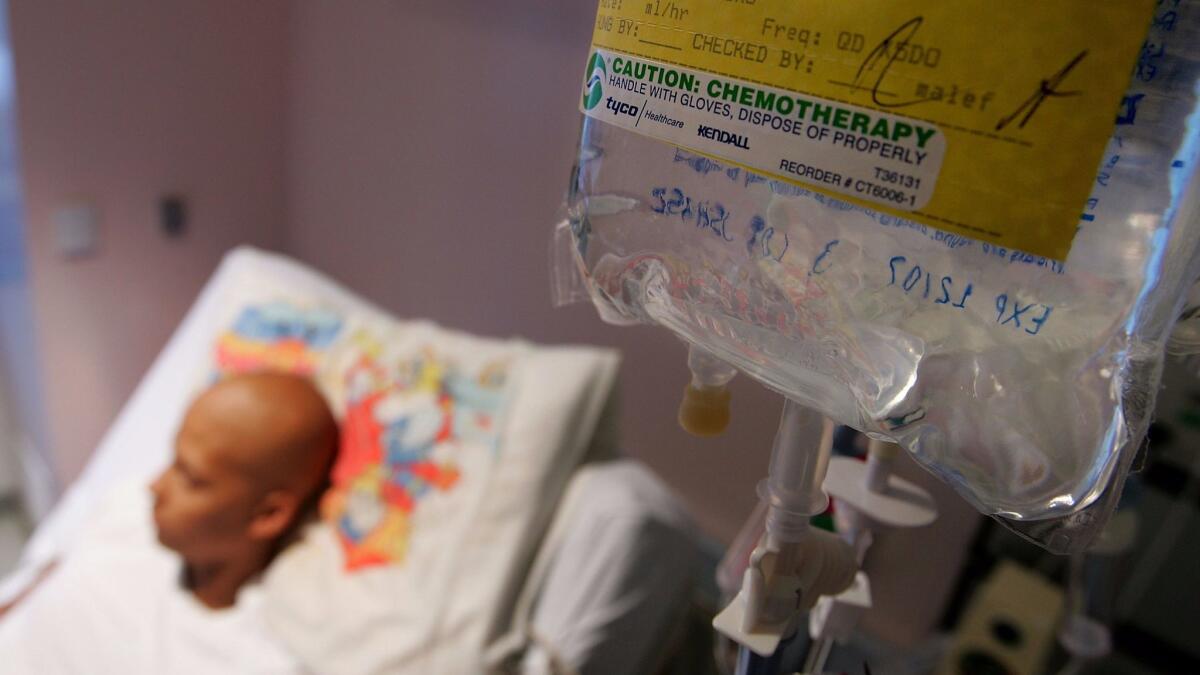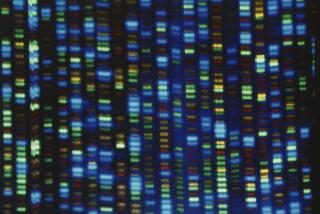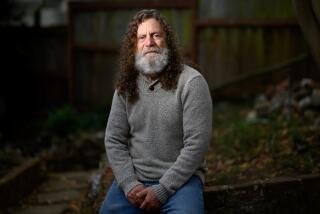‘Bad luck’ with random DNA errors is responsible for two-thirds of cancer mutations, study says

Even in a world with a pristine environment, no cigarettes and the ability to fix faulty genes inherited from our parents, most of the cancers diagnosed today still would occur thanks to a combination of biology and bad luck.
Every new case of cancer depends on a collection of specific mutations in our DNA, and a sweeping new study finds that 66% of the mutations that put us at risk for cancer are the result of unavoidable errors made by cells as they copy themselves millions of times throughout our lives.
In research published Thursday in the journal Science, geneticist Bert Vogelstein and biostatistician Cristian Tomasetti demonstrate that most cancer risk stems not from bad genes, environmental toxins or poor lifestyle choices, but from simple random mutations.
Every time a normal cell divides, about three mutations occur. The body has ingenious DNA-repair mechanisms to limit the damage, and not all mutations occur in parts of the genome that are active. So sometimes our luck is good, Vogelstein said.
But, he added, “we cannot stop ourselves from making mistakes.”
The new work confirms and extends the findings of a 2015 study that challenged some of the cancer community’s bedrock beliefs about malignancy.
By attributing a large share of cancer risk to DNA errors that arise randomly, Vogelstein and Tomasetti appeared to suggest there was little we could do to prevent cancers. That drew howls of protest from researchers and public health experts who have spent careers establishing the powerful role that behavior change and pollution control can play in driving down cancer rates.
The study authors took pains to quell those concerns. Their findings, they said, “complement rather than oppose” authoritative estimates suggesting that 42% of cancer cases could be prevented with improvements to lifestyle and environment.
That should underscore the need for humans to keep practicing behaviors that reduce their cancer risk, they said.
Even so, the idea that randomness is a reigning factor in cancer risk “is here to stay,” Tomasetti said. The result is “a complete paradigm shift in how we think about cancer and what causes cancer.”
In their new research, Tomasetti and Vogelstein, both of Johns Hopkins University in Baltimore, examined data on 32 kinds of cancer, from the brain to the bones to the blood. They found that 5% of cancer-causing mutations can be linked to inherited genetic risk, such as the BRCA gene variants that dramatically increase the risk of breast and ovarian cancer in women who carry them.
An additional 29% of malignancy-promoting mutations can be attributed to “modifiable” factors — things we can do something about, such as wearing sunscreen and vaccinating ourselves against cancer-causing viruses.
The remaining 66% of genetic mutations known to give cancer a foothold are random transcription errors in DNA, the pair concluded.
To understand what this means, Vogelstein said, imagine this: Take an average person and magically strip out all her cancer-risk genes. Place her on a pristine planet where smoking, sun exposure and industrial pollution does not exist, and where “everyone drinks kale shakes.”
Over the course of her life, this average human’s stem cells still would generate nearly two-thirds of the cancer-driving mutations that she would have if she lived on Earth with her full complement of inherited risky genes and bad habits.
“That’s just evolution,” Vogelstein said.
The pair’s insights into cancer’s causes help explain two widely recognized trends in cancer: that the disease is more common the older we get, and that malignancies are more frequently seen in some tissues than in others.
Both of those observations are firmly grounded in the “bad luck” theory.
As we age, not only do we experience more environmental exposures that can cause cancer-driving mutations, we also accrue a lifetime’s worth of random cancer-driving mutations from our cells’ constant replication. To make matters worse, cell replication speeds up as we age, increasing the probability of errors.
As we get older, in short, the likelihood increases that all the mutations needed to jump-start cancer will fall into place.
Similarly, some human tissues have a higher rate of cellular “turnover” than others. With that rapid replication of new cells comes a rising probability of transcription errors.
In both of their studies, Vogelstein and Tomasetti plotted the lifetime incidence of various cancers against the estimated number of normal stem cell divisions in 17 different types of tissues over a lifetime. (They focused on stem cells because they develop into so many other kinds of cells, so any errors they contain have the potential to spread quickly.)
The overlap was almost exact, suggesting that cancers in tissues with high rates of cellular turnover — including brain, kidney, colon and liver — were far more common than could be explained by inherited or environmental factors.
Vogelstein and Tomasetti’s original study focused on cancer trends in the U.S. In the new study, they analyzed data from 69 countries spanning six continents. The inclusion of cancers from nearly half the world’s population suggest the findings can be generalized to all people, transcending environmental differences and ethnicities.
The new study also extended the prior results by including cancers of the breast and prostate, two of the most common malignancies. Both prostate cancer in men and breast cancer in women were strongly driven by “bad luck.”
Song Wu, a Stony Brook University biostatistician who has contested Tomasetti and Vogelstein’s findings, said the prostate cancer results suggest the pair have again overestimated the role of chance in cancer. Several studies of immigrants, including Japanese men who move to the United States, have shown that prostate cancer incidence increases markedly in their new home.
“There’s clearly something happening in the environment,” Wu said. To argue that prostate cancer risk is hardly driven by environmental factors, he added, “is a very bold claim. That makes me a little bit skeptical.”
The new research also finds that childhood cancers appear almost entirely driven by randomly occurring mutations.
Vogelstein, a pediatric oncologist, said he hoped that finding, especially, would offer comfort to the parents of children who develop pediatric cancers.
“They need to understand [their children] would have developed these cancers no matter what they did,” Vogelstein said. There’s no need for them to feel guilty.
All this is not to say that two-thirds of all cancers are caused by bad luck or that only 29% of cancers could be prevented with healthier lifestyles and a cleaner environment, Tomasetti and Vogelstein said. Many cancers require several mutations to get going, and most are a mix of mutations linked to random and environmental factors.
By not using tobacco, for instance, most people deny lung cancer the full complement of mutations it needs to take hold. Vogelstein and Tomasetti found that in lung cancer, 65% of mutations are caused by environmental factors, including smoking and air pollution, while 35% stem from random transcription errors.
Not smoking is clearly no assurance of preventing lung cancer — after all, just over 1 in 10 lung cancers occur in nonsmokers. But it will clearly reduce the risk that all the necessary mutations will align.
When even one mutation necessary for cancer to take hold is caused by the environment, Tomasetti said, that “is enough to make a cancer preventable.”
Paul Meltzer, a leading geneticist at the National Cancer Institute’s Center for Cancer Research, called the new study “very important theoretical work” that will set the direction for cancer research. By flagging cancers that appear to be largely explained by random mutations, Vogelstein and Tomasetti have given cancer researchers mysteries to solve — and potential targets for new treatment approaches.
“Something we don’t consider a modifiable risk factor today might look modifiable in the future,” Meltzer said. “What we call the ‘bad luck’ in the gene replication, we may have ways to reduce that in the future.”
Such revelations may not be close, but they’re “completely possible,” he said. “Those discoveries will change the equations here.”
In the meantime, Meltzer said, patients should learn what steps they can take to prevent cancer and follow them.
MORE IN SCIENCE
New view of dinosaurs could radically reshape their family tree
Gun injuries cost Americans $730 million a year in hospital bills
Sorry, moms: Prenatal vitamins with DHA won’t boost your kids’ IQ after all
UPDATES:
4:15 p.m.: This story has been updated to include additional detail about the study as well as comments from biostatistician Song Wu.
This story was originally published at 1:35 p.m.







